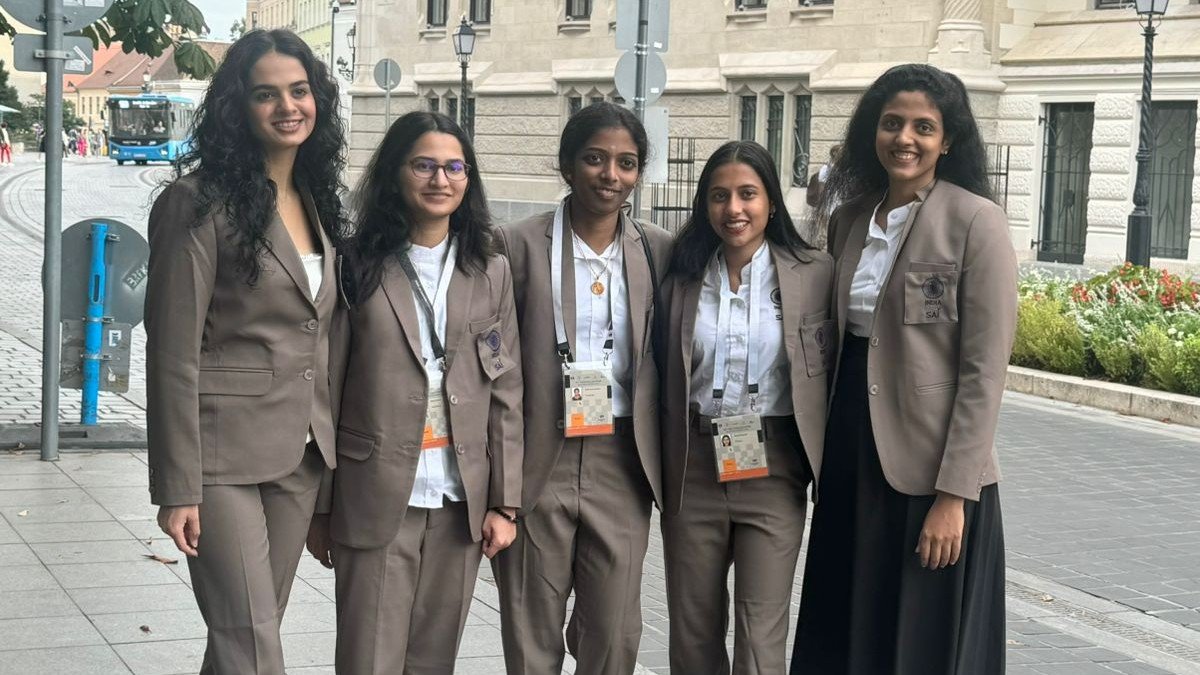The chess equivalent of the Olympics – the Chess Olympiad, is being held in Budapest, Hungary from October 11-22. When India hosted the previous edition in Chennai, the Indian teams won a Bronze Medal in both sections.
The Chess Olympiad is a biennial event played as an 11-round Swiss-system team tournament in the classical time control, with the Open and Women’s sections running simultaneously. This year about 197 teams compete in the Open section, and 183 in Women! Besides National teams, a special Refugee team plays in each section.
This year, India has fielded the strongest ever team in the Open section. Starting out as the 2nd seed, our all-Grandmaster team comprises of D.Gukesh (Board 1), R. Praggnanandhaa (Board 2), Arjun Erigaisi (Board 3), Vidit Gujrathi (Board 4) and P.Harikrishna (Reserve board i.e. Board 5). GM Srinath Narayanan is the non-playing Captain. The Indian Women’s team are top seed as well. Our team comprises GM D.Harika (Board 1) , GM R.Vaishali (Board 2), IM Divya Deshmukh (Board 3), IM Vantika Agrawal (Board 4), and IM Tania Sachdev (Reserve Board i.e. Board 5). GM Abhijit Kunte is the non-playing Captain.
Let’s get familiar with the nuances of a Team based approach in Chess:
Board assignments
A five-player team is assigned to Board 1, Board 2, Board 3, Board 4, and Reserve Board at the start of the event. Each match involves four games against the opponent team. In every round one player is rested. The rest of the players can be fielded on their own board or pushed one board higher, depending on Match Strategy.
The four games are played individually by the players assigned against their counterpart, without consultation with each other or the Captain. They play with alternate colours on alternate boards, with the top board playing with the colour assigned to the team in the pairings. For example, if a team is assigned ‘Black’ in the pairings, players on Board 1 and 3 play with Black and players on Board 2 and 4 play with White, ensuring greater fairness. The cumulative points across all four Boards (Board points) form the team points (Match Points). Match Points decide standings, however Board Points help in case of a tie. A team can score up to 4 board points every match, but 2.5 wins and 2-2 draws. Therefore, even if players cannot collaborate, one can guide their game based on team needs. If a player is losing on his board, his teammates may take more chances midway to push for victory on their Boards. In another scenario, 3 players may play for a draw while depending on the 4th player to score a full point and bring in Match Victory.
The Captain determines the team board order, match-specific board order, and the pre-game Match strategy. Like in any team game, the captain’s attitude holds the key to creating a healthy environment in the team built on trust, good energy and open communication channels, eventually culminating in a great result!
Board order
The traditional approach to assigning a player to a Board is:
Board 1: The team’s top player competes with the best from other teams on Board 1: Gukesh returns to the top board this year, who in 2022 trail-blazed the team to a Bronze medal with a 9/11 score on Board 1!
Board 2: Many Teams aim for Board 1 and 2 to stay solid against strong teams and score against the weaker ones. The ever-dependable Harika Dronavalli plays Board 1 for the Women’s team this year; in the previous edition she held the fort on Board 2 while being 8 months pregnant!
Board 3 and 4: Dynamic players are typically fielded on Boards 3 and 4 (the Reserve Board plays on Board 4 in case of rests) to score heavily against equal or weaker opponents. These boards may also feature slightly less experienced players than the top boards, though that’s not the case with the current Indian teams.
Players’ roles
Based on playing style and team composition, some teams may place their top players on the second, third, or even fourth Board. Fielding a strong player on a lower board opens an opportunity to score more points, provided the players on the higher Boards hold off their higher-rated opponents. After all, a win on the 3rd or 4th Board earns the same points as one on the top 2 Boards! Vaishali, Tania and Bhakti scored heavily on the lower boards for India in the previous edition. India’s highest-rated player, World number 4 GM Arjun Erigaisi plays on Board 3 this time! This strategy also permits the player to move 1 board higher (which is impossible on board 1), so one may choose to play against a specific opponent, or with a specific colour, utilising the flexibility.
Lastly, team tournaments often come down to one player rising to the occasion when the others are having a bad day, and the team delivering during a crucial round. Magic happens when mental skills combine with technical skills. With such a world-class squad this year, let’s back our Chess Wizards to Accio Gold!
(Soumya Swaminathan is an International Master and Woman Grandmaster in Chess. She has been World Junior Champion and Commonwealth Gold Medalist)




